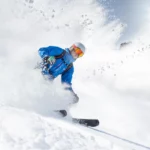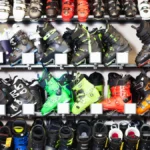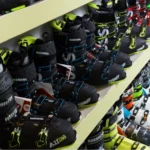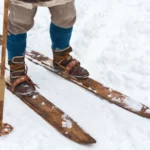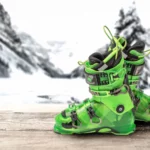Best Ski Boots for Wide Feet – 2023/2024

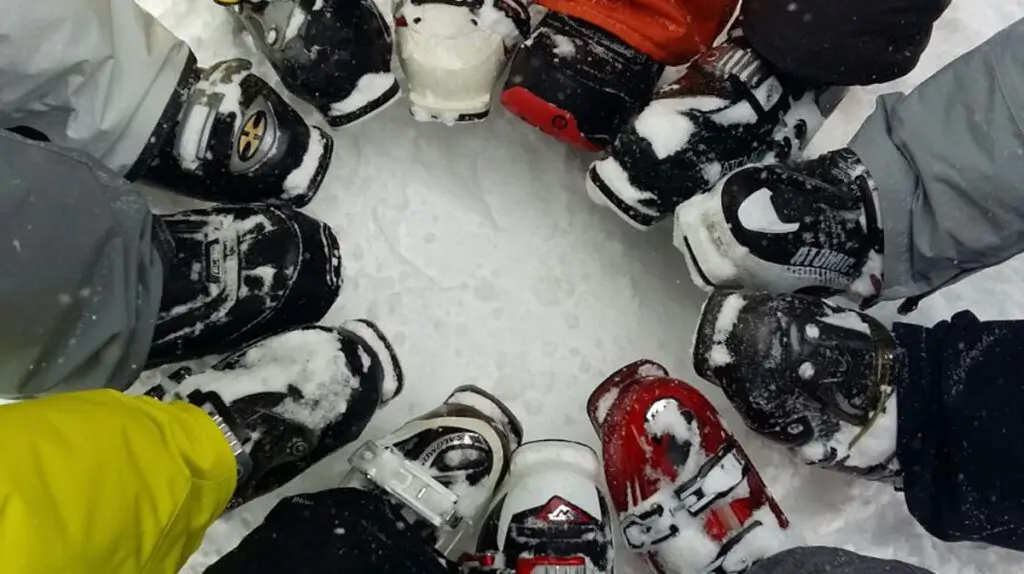
Editor's Note: This post contains affiliate links. While we may earn a small commission, our recommendations remain unbiased and are based solely on our independent research. Learn more about us.
Finding a properly fitting ski boot can be challenging, especially if you find that most boots are too narrow for your feet. Fortunately, the ski boot industry has become more accommodating of wide feet, and the number of ski boots for wide feet has grown. To help you find the very best fit, we’ve researched the latest ski boots on the market and reviewed 34 makes and models in order to objectively identify the best ski boots for wide feet.
Top Picks
Here is a quick summary of our recommendations. More details on each of our picks can be found below.

- Nordica SPORTMACHINE 3 80 2024
- Best Wide Ski Boots for Beginners - Men
- MSRP $299.99
- Flex 80
- Last 102 mm
Best Wide Ski Boots for Experts – Men
Tecnica Mach1 HV 130

- MSRP$799.95
- Flex130
- Last103 mm
The Tecnica Mach1 HV 130 is our pick for the best wide men’s ski boot for experts for several reasons. Notable for its solid stance, excellent power transfer, and quick responsiveness, the boot will contribute to a great performance on the slopes. Unsurprisingly, the Tecnica Mach1 boot series has an impressive history of receiving awards and recognition from expert testers in the industry.
The Mach1 HV 130 is a high-volume fit ski boot, featuring a last of 103mm. It provides more volume throughout the boot and comes with a Velcro spoiler for additional adjustments. It has a 130 flex and is designed for advanced skiers who are looking for efficient energy transfer. It features Tecnica’s innovative T-Drive technology which enhances power transmission. It is designed for all-mountain and freeride skiing.
Pros
- Great out-of-the-box fit and performance
- Good dampening on choppy runs
- High-end materials
- Highly customizable fit
Cons
- Does not have a walk mode
- On the pricey end
- On the heavier side
Specs & Features
- Flex: 130
- Last: 103mm
- Soles: Gripwalk
- Weight: 2040g
- Liner: C.A.S. Liner heat-moldable
- Shell: C.A.S. Shell heat-moldable and punchable
- Four micro-adjustable Lift Lock buckles
Best Wide Ski Boots for Experts – Women
Atomic HAWX Magna 105 S W GW

- MSRP$599.95
- Flex105
- Last102 mm
The Atomic Hawx Magna 105 S W ski boot shines with strengths that cater to a wide variety of skiers, from intermediate all the way up to expert level. Its wide fit design, accommodating a 102mm last width, ensures comfort for wider feet, and the PU shell and cuff materials offer durability and a good flex level. In fact, these boots perform similarly to boots rated 120 flex. Through the years, the Atomic HAWX Magna series has earned many accolades from testers and owners.
Several features make the Atomic Hawx Magna 105 S W GW ski boot stand out. The Prolite construction strategically reinforces the boot for stability and precise skiing performance while maintaining a lightweight feel. The Mimic Gold W liner, which is heat moldable, ensures a customizable fit by conforming to the contours of the foot and leg. The boot’s 3D Stretch Toe Box and 3MTM Thinsulate Insulation keep the feet warm and comfortable in varying conditions. The Power Shift mechanism allows skiers to adjust the forward lean and flex, making further customization possible.
Pros
- Great out-of-the-box comfort and fit
- Customizable fit options
- Great power transfer and responsiveness
Cons
- No walk mode
- Somewhat expensive
Specs & Features
- Flex: 105
- Last: 102mm
- Soles: Gripwalk
- Weight: 1,814g
- Removal Cuff spoiler
- Heat moldable pre-shaped “Mimic Gold” liner
Best Wide Ski Boots for Intermediate – Men
Nordica HF 110

- MSRP$649.99
- Flex110
- Last102 mm
The Nordica HF 110 is a stand-out ski boot that provides comfort and solid precision out of the box for the avid skier. This model features a large volume with 102mm last and rear entry, which makes putting the boots on relatively easy. Combined with a flex index of 110, this ski boot provides a solid blend of comfort and performance for intermediate-level skiers.
The 3D Cork Fit Primaloft® liner aims to create a precise custom fit with improved warmth and shock absorption. The Infrared Technology offers customization of the boot’s shell and cuff, which are both constructed from Infrared PU so that you can enhance control and fit. The Monolock buckle system and the Easy Entry Shell design streamline the process of putting on and taking off the boots. At the same time, the Double Axis Pivot ensures a seamless closure, enhancing the boot’s performance.
Pros
- The hands-free closure system with rear entry
- Comfort for wider and larger volume feet
Cons
- Rear Buckle had some quality issues in previous models
- A few owners mentioned they struggled to get the rear buckle really tight
Specs & Features
- Flex: 110
- Last: 102 mm
- Soles: Gripwalk
- Weight: 1760g
- Liner: 3D Cork Fit Primaloft® and heat moldable
- Rear Entry
Best Wide Ski Boots for Intermediate – Women
Nordica HF 85 W GW

- MSRP$649.99
- Flex85
- Last102 mm
The Nordica HF 85 W has earned a loyal fan base due to its innovative designs. It features the Nordica Hands-Free entry system that has a generous opening angle of 40 percent, allowing for a hassle-free experience with putting on and taking off the boot. There is also a single buckle at the back of the cuff which can be opened or closed with your other boot or ski poles so that you don’t have to remove your ski gloves.
A flex Index of 85 caters to intermediate and advanced skiers by balancing flexibility and control. This is not a racing boot, but owners and testers don’t have any complaints about how it responds. The Double Axis Pivot contributes to a tighter fit and better lateral support, enhancing ski handling. It also works to provide a snug fit between the cuff and shell.
With a 102mm last and the infrared customizable shell and liner, this ski boot is able to achieve a comfortable fit for wider foot shapes. The 3D Cork Fit Primaloft Liner is designed to provide a precise custom fit, as well as increased warmth and shock absorption. For additional comfort, Nordica has added the Elite series to its line of boots that come with a battery-powered heated liner, controlled via a smartphone.
Pros
- The hands-free closure system with rear entry
- Flexible fit for various foot sizes and shapes
- Strong lateral support for performance control
- Battery-powered smart heated liner included
Cons
- Rear Buckle had some quality issues in previous models
Specs & Features
- Flex: 85
- Last: 102 mm
- Weight: 1750g
- Soles: Gripwalk
- Liner: 3D Cork Fit Primaloft® and heat moldable
- Rear Entry
Best Wide Ski Boots for Beginners – Men
Nordica Sportmachine 3 80

- MSRP$299.99
- Flex80
- Last102 mm
The Nordica Sportmachine 3 80 ski boot is highly appreciated for the out-of-the-box comfort it provides. This no-fuss ski boot delivers solid comfort and performance at a great price point.
The boot has a roomy 102mm last, making it a comfortable home for those with larger, wider feet. Both the shell and cuff are made of polyurethane, which is known for its quality and flexibility. The liner is A Nordica 3D Cork Fit Primaloft Liner which can be customized to achieve a better fit. The Nordica Sportmachine 3 80 also features an Adjustable Cuff Profile (AC) that can be further adjusted to match the shape of your calf. Additionally, soft plastic inserts on the throat of the cuff create a wider opening that simplifies getting in and out of the boot.
This model is the softest flex member of the industry-recognized Nordica Sportmachine 3 ski boot family and is designed for beginner to intermediate skiers. The design provides comfort while still offering good power transfer. It comes with an 11-degree forward lean and a standard ramp angle of 4.5 degrees, which is well-suited for beginners.
Pros
- Reasonable price
- Comfortable out of the box
Cons
- No walk mode
- No Gripwalk soles
Specs & Features
- Flex: 80
- Last: 102 mm
- Weight: 1700g
- Soles: Standard Alpine (5355 PU)
- Liner: 3D Cork Fit Primaloft® and heat moldable
- Liner: Comfort Fit and heat moldable
- Easy Entry Soft Flap
Best Wide Ski Boots for Beginners – Women
Salomon QST Access 70

- MSRP$379.95
- Flex70
- Last104 mm
The 2024 Salomon QST Access 70 continues the QST Access family’s tradition of comfort and ease of use. It is a boot designed for comfort and warmth, aimed at beginner to intermediate skiers.
The boot is very roomy, with a 104mm last and high volume that’s ideal for skiers with wide feet. The three-buckle design with a ratchet buckle on the cuff allows for easy adjustments to accommodate a range of calf sizes, making it stand out compared to other boots in the market. It is no surprise that this boot has earned high praise from owners for comfort.
Performance-wise, the boot’s soft flex index of 70 is suitable for beginner to intermediate skiers who prefer a more forgiving boot. The oversized pivot improves power transfer from the cuff to the shell. It also features a walk mode to help get around once off the slopes.
Pros
- Noted for comfort and warmth
- Walk mode
Cons
- Soft flex will not keep up with more demanding skiing
Specs & Features
- Flex: 70
- Last: 104 mm
- Weight: 1542g
- Soles: Gripwalk
- Liner: My CustomFit comfort
- Walk mode
Best Affordable Wide Ski Boots
K2 BFC 90

- MSRP$399.95
- Flex90
- Last103 mm
As a member of the highly regarded K2 BFC (Built For Comfort) boot family, the K2 BFC 90 delivers comfort for a full day on the slopes. The boot is designed for beginner to intermediate all-mountain skiers with wide feet.
The boot features the softer TPU material in the instep area, which opens wider and allows for easier entry and exit out of the ski boot. Both the shell and cuff are heat moldable, allowing for additional fit adjustments. The liner is a CushFit liner, a blend of open-cell and EVA foam; however, it is not heat moldable. The BFC 90 also features grip walk pads for easier walking around the lodge and parking lots.
The boot has a flex rating of 90, providing a supple yet supportive feel suitable for beginners to intermediate-level skiers. Built with softer materials, this boot is not built for race-level responsiveness, but it does provide a more forgiving ride.
Pros
- Comfort out of the box
- Good throat volume in the cuff area which can be adjusted
Cons
- The liner is not heat moldable
- Skiers might outgrow the soft boot flex quickly as their skills advance
Specs & Features
- Flex: 90
- Last: 103mm
- Weight: 1920g
- Soles: Gripwalk
- Liner: Cushfit Plus
- Cuff and sheel are heat-moldable
Buying guide and tips for ski boots for wide feet
It is “the” challenge for many skiers to find a comfortable and performing ski boot. Not too long ago this challenge was even more significant for skiers with wide feet. Fortunately, the industry has developed more ski boot designs that accommodate a wider variety of foot shapes and widths. If you are a skier with wide feet, closely considering the following list of design elements can help you find the right ski boot for you. Here are a few tips, but for more information, you can read our ski boot buying guide with detailed information.
Ski Boot Last
A ski boot last measures the width of ski boots in millimeters. Until recently ski boots didn’t come in many varieties of last, which limited fit options for skiers with wider or narrower feet. To accommodate their foot shape, skiers are often required to size up or down, which often leads to performance issues, not to mention pain and discomfort.
Ski boots are now available in various widths to better accommodate different foot shapes. Wider boots also offer more overall volume, enhancing comfort while maintaining performance. This shift has been crucial in improving the skiing experience by ensuring a better fit for diverse foot sizes.
Customizable Shell and Liner
Customizing a ski boot shell and liner significantly enhances the skiing experience by improving comfort, performance, and safety. A tailored fit reduces pressure on the foot, allowing for longer skiing sessions without pain. A customized boot also improves the skier’s control and precision on the slopes, translating to better performance and control.
Boot fitters can perform shell modifications to match the boot’s shape to the skier’s foot and ankle contours, ensuring a perfect fit. They can also adjust the boot’s canting, aligning the boot with the skier’s natural leg position for improved balance and control. What’s more, they can modify the liner – either by heat molding it for a custom fit or by adding padding in specific areas – to alleviate pressure points.
Not all ski boots are customizable, so be sure to factor this into your selection decision.
Footbeds
Footbeds sit inside the liner and are what your foot stands on. They play a crucial role in ensuring a better fit as they provide tailored arch support, align the foot correctly inside the boot, and prevent further widening of the foot. This alignment not only enhances comfort by distributing pressure evenly but also improves overall balance and control, essential for effective skiing. If necessary, you can swap the liner for customized ski orthotics to achieve a better fit for your foot.
Rear Spoilers
A rear spoiler in ski boots enhances skiing performance by promoting a forward-leaning stance for better balance and control, and provides extra calf support for comfort and less fatigue, depending on the shape of your calf.
These wedges are removable and can reduce the gap between your leg and the boot shell if you have more slender calves. However, for folks with wider calves, these spoilers can be removed to increase the volume at the throat of the boot.
Skill Level and Flex Rating
Skill level, flex rating, and ski boot fit are all closely related. Skill levels are defined as beginner, intermediate, expert, and advanced. Flex ratings range from soft (typically 60 – 90), medium (90 – 110) and stiff (110 and above), where softer boots are more suited for beginners and stiffer for advanced skiers.
Beginner skiers can get away with larger, comfier ski boots, as flexibility is needed when first starting out. However, as your skill level grows you will find that the added comfort and softness of the boot do not provide responsiveness and performance needed for handling more challenging terrain. Specifically, your foot will start to swim in the boot, and the boot will absorb some of the foot commands that were meant for your skis.
Advanced skiers prefer tight-fitting boots and stiffer flex, ensuring they have instant command of their skis.
Advanced skiers with wide feet often struggle to get the right fit. However, with wider boots being made with different flex levels, the options have substantially improved.
FAQs:
How comfortable should wide ski boots be?
Ski boots, and wide ski boots, should avoid any pressure points or tightness while still providing support and control. The fit should be snug to prevent floating or loose movement inside the boot. However, there should be enough room to accommodate the natural spread of the foot when supporting the skier on the slopes. The toes should be able to wiggle slightly, but not so much that they don’t touch the front of the liner. The heel should stay locked in the heel pocket and not lift or raise as you lean forward.
How to find a wide ski boot?
Ski boots come in three widths, known as ski boot last: narrow (97–98mm), medium (99–101mm) and wide (102mm and up). When looking for wider ski boots, look for boots with a last of 102mm or higher.
How do you know if you need a wider ski boot?
If you are feeling pressure on the side of your foot, or instep area, and ankle, but your toes aren’t touching the front liner, you will want to look for a wider boot with more volume.
